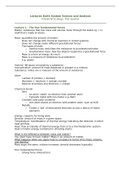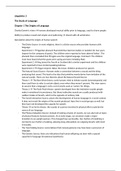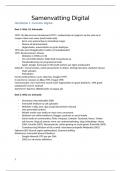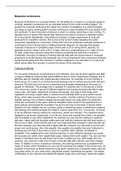Industrial Ecology, first quarter
Lecture 1 – The four fundamental forces
Matter: substance that has mass and volume. Goes through the states (g, l, s).
Stuff that’s made of atoms.
Mass: quantifies the amount of matter.
- Does not change with chemical reactions in closed systems
- Does not change under different gravitational forces
- Two types of mass
o Inertial mass: describes the resistance to acceleration/motion
o Gravitational mass: how the objects respond to a gravitational force
- Mass is a form of energy (E=mc2)
- Mass is a measure of resistance to acceleration
- E.g. grams
Volume: 3D space occupied by a substance
Concentration: amount of mass dissolved or present in a mixture
Substance: moles are a measure of the amount of substance
Atom:
- number of protons = element
- #protons + neutrons = isotopic number
- Balance of protons and electrons = charge
Chemical bonds
- Ionic
o An atom ‘steals’ an electron from another atom
o Typically metal with non-metal, e.g. NaCl
- Covalent (and polar covalent)
o Ann atom shares an electron with another atom, such as H2O
- Metallic
o Create a ‘sea’ of delocalized electrons across a lattice of metal
elements
Energy: capacity for doing work.
Density: amount of mass in a given space
Temperature: manifestation of thermal energy indicating the direction in which
heat will flow
Heat: flow or transfer of thermal energy from or to a thermodynamic system.
Heat is kinetic energy contained in vibrating atoms.
What is the difference between mass and matter?
You need mass to have matter? Mass in an amount of matter.
What happens when you apply heat to an object in terms of its mass, volume,
and density?
Mass stays the same, volume increases, density decreases (typically)
Four fundamental forces
- Strong force (interaction)
, o Spillover of this force keeps the nucleus together (3x magnitude
stronger than electromagnetic force)
o Quarks that make up hadrons (e.g. protons and neutrons) are kept
together by strong force
o Because of strong force matter in the universe exists
- Weak (interaction)
o Exchange of particles called force carriers
o Responsible for radioactive decay
o Called weak because it’s a very small range
o changes the identity of particles
- Electromagnetic (interaction)
o Has an infinite range and is responsible for much of the phenomena
we experience on a daily basis (e.g. radiation, mag field of the
earth)
o ++, --, +- interactions
o Photon
Hotter object = higher vibration = radiate energy
- Gravitational force
o Responsible for the motion of astronomical objects
o When two objects are gravitationally locked, their gravitational
force is centered at the barycenter of the system
Earth’s spheres
- Atmosphere: air
- Hydrosphere: water
o Cryosphere: ice
- Biosphere: life
o Auto and heterotrophs (and more)
o Chemoauto
troph:
chemical
energy
from light,
carbon self-
create?
o Chemohetr
otroph: no
chemical energy from light, get carbon from others











